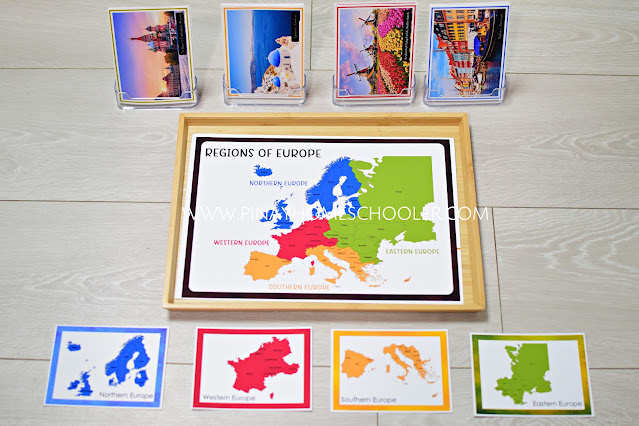The second part of European Study includes the animals and their habitats, the landmarks of Europe, the culture, the foods, the people in history and the natural resources that can be found in this continent.
For the first part of this unit study click here.
Animals of Europe. I make use of the existing materials that we have including the cards and the animal figures which I got from Safari Toobs and Schleich. Here we talk about the animals and their habitats, how they differ from the animals in other countries like Asia, how they adjust on the weather, what they eat, how they survive etc. (click the image below for the link of the file)


Below, after identifying the animals that lives in Europe, we sort them according to their diet (herbivores, carnivores and omnivores).


Afterwhich, we also discuss their habitats, which animals live in the forest, rivers... as seen on the picture Mavi draw a forest for the wolves, deer, bears and lynx.

Landmarks. We are fortunate to have visited most of these places, thus Mavi was easily interested learning about them. I showed him some pictures from our travels, talk about how these landmarks are important and what made them icons. (click the image below for the link of the file)

Seen on the picture below, Mavi traced the places we've been in the map. I showed him pictures of the Euro trains that we used as a means of transport in the mainland Europe. Aside from this, I also showed him pictures showing the culture and practices of the different countries in Europe.

And additional activity I added was a matching game. Here Mavi matches the landmarks to the country flag of their location.


And I whipped a little bit of spelling practice as well. We use the moveable alphabet to name the flag of the country they represent. Oh my! He worked on this all by himself. You can get the flags from here.


Here's something new for this year, our Natural Resources cards which we used to talk about the treasures from nature that can be found here in Europe and that are used for human consumption. To know more about this file read about it here or you can click the image below for the link of the printable. (click the image below for the link of the file)

As we discuss, it happens I have an antipasti (olives and garlic) and showed it to him. Once we discussed all of the natural resources, he decided to draw these resources as well. See photos below.



And a little more discussion but we didn't really focus on these are the foods and the people in the history of Europe. The only he's interested about is the food which he is very much familiar with because we mostly have them at home like the pasta, paella, baguettes, crepes, churros and gyros. We sometimes visit the Coco Market at the park to have a taste of some European cuisines and the Spain and Greek dishes are always a favorite! (click the images below for the link of the file)


For the materials seen on this post visit:
European Study Printable Materials
Natural Resources of the World.
For our previous European Unit, click Part 1 and Part 2.
Next we'll study some of the famous artists in Europe, Math using Euro and more!
For more FREEbies and learning aids, please check The Pinay Homeschooler Shop and Downloads.
Linking to:
Montessori Monday
TGIF Linky Party
Teach Beside Me
Preschool Corner
Teaching Mama
I Can Teach My Child
Home + School = Afterschool!
Natural Homeschool's Montessori Linky

























![DSC_2545_thumb[4] DSC_2545_thumb[4]](https://blogger.googleusercontent.com/img/b/R29vZ2xl/AVvXsEhBGYASCxcEn3X0lC8UI_7j-N2IOvJrD6BT3FCRtajd-Th_T0413gmfzkGNzm_2pQO36yFdBNcrkbSIN66CD_oiwWwqEbGuR1RJmBM7bhJS6PUwc4Qaj6z45mm7QD9yJayIJpk1d_PCxAg/?imgmax=800)


































